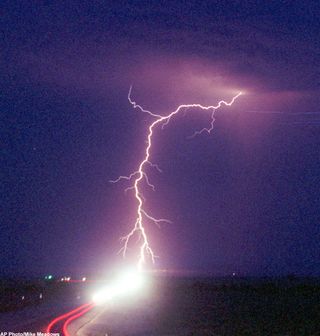
What Autumn Means to Meteorologists

This article was provided by AccuWeather.com.
Autumn means many things to many people, but in the world of weather and to meteorologists it means exciting times and a lot of worries.
While just about every meteorologist loves thunderstorms during the spring and summer, fall marks a time when meteorologists can have their cake and eat it too. On the weather maps, it is meteorological chaos.
Fall is a battle of two seasons: summer and winter with winter eventually winning the tug of war.
We asked our meteorologists about their concerns during the sometimes rapidly changing weather.
AccuWeather.com Senior Vice President Evan Myers feels that the biggest challenge is helping to get people acclimated to the rapidly changing fall weather.
"During the summer, people get used to rain only lasting a few minutes to an hour or so, but in the fall, as the storm systems get bigger and bolder, rain can last all day or multiple days," Myers said.
Sign up for the Live Science daily newsletter now
Get the world’s most fascinating discoveries delivered straight to your inbox.
As the storms get bigger, so do the waves of cold air. There is greater potential for weather shock once a strong cold front moves through.
"The first frost or freeze of the season is another big forecasting concern we have," Myers stated. "It is a big deal for agriculture, the homeowner who has a garden or anyone who parks their car outside and has to scrape their windshield before getting to work."
One of AccuWeather.com veteran meteorologists, Dave Dombek, has concerns dealing with temperature.
"Everybody knows that the weather turns progressively cooler in the fall, but sometimes it is hard for people and forecasters to keep up with the trends and everyone's perception may be different," Dombek said.
Normal average and record temperatures trend downward at a rapid pace spanning September through early December.
"A high temperature of 59 degrees on Sept. 30 in New York City might not seem so bad, but for example, coming off unusual warmth during September and October, with many prior days with highs in the 70s to low 80s, such a day can have more impact," Dombek said.
During the summer, because of the long daylight hours and strong sunshine, it is very rare for it to stay cloudy all day, and we have an excellent chance of rebounding to forecast high temperatures.
Temperature forecasts can be more challenging in the autumn. There are those days in the fall when clouds hang on or move in after a clear, chilly night.
"During the fall, daylight is short and the sun is weak, compare to summer," Dombek stated, "You have much less time to hit that forecast high temperature."
"Wabbit Season! Duck Season! Fog Season!"
As many birds take to the skies for their annual southward migration and wild animals begin gathering food and bulking up for the winter, the combination of longer, cooler nights and lakes and rivers remaining warm brings the right conditions for fog.
Anyone who has traveled through the river valleys this time of the year knows how dangerous and disruptive the fog can be.
According to Chief Meteorologist Elliot Abrams, "Not only is it easier for fog to form this time of the year, but it can also take longer for fog to burn off in the morning, due to the weakening sun."
That can mean many travel delays and risk of accidents on the roadways.
"We don't always have fog the first night after a cool front moves through, but when winds diminish by the second night, it is almost always a problem," Abrams said, "Of course, once the fog is gone, it won't be mist (missed)."
Fall means other potential problems in different parts of the nation.
In the South, it may mean relief from a long summer of heat and humidity, or the end of days of delight if that's your taste, but it also means careful watch of the tropics.
According to Tropical Weather Expert Dan Kottlowski, "In the islands and along the coasts of the Gulf of Mexico and the Atlantic Ocean, we have the heart of hurricane season to contend with."
Who will get on a hurricane's wrong side with high winds and flooding rain versus who will stay west of the storm with sunshine and warmth? How quick will cool air sweep in after the storm passes?
"In most years, it is not until the jet stream and its dry air takes a big dip deep into the tropical Atlantic during November before we see an end for tropical cyclone worries," Kottlowski said.
While risks from a tropical storm are rare in the western U.S., there is a big problem almost every year with wind from a different sort.
According to Western Weather Expert Ken Clark, "Fire weather often continues in the West well into the fall, due to the dry brush and the potential for increasing wind events as non-tropical storms strengthen across the north."
Santa Ana wind events and other local winds in California can whip small blazes into raging firestorms in a matter of minutes threatening countryside communities and major cities alike.
Severe weather is also an occasional concern in the autumn as well as when large-scale storm systems bring the lingering warmth over the south together with the building chill to the north.
This secondary severe weather season can lead to isolated tornadoes and squall lines that cover hundreds of square miles.
And that Four-Letter Word: Snow!
In the West, the high mountains and passes of the Rockies are usually the first to get snow for the season and that begins to present cross-country travel concerns.
Veteran meteorologist Bernie Rayno stated, "At a mile above sea level, Denver is a hot spot for early-season snowstorms when the wind blows uphill from the Plains."
In this case, the ascending air rapidly cools and moisture condenses, sometimes in the form of heavy snow.
Heavy snow can also make rare early-season appearances in the East and Midwest. Recall the freak snowstorm in the Northeast during October 2011 which brought down trees and power lines.
According to Expert Senior Meteorologist John Kocet, "Around the Great Lakes, it can be 70 degrees one day and the next day crazy with wind-whipped cold air, bringing rough seas, thunderstorms, waterspouts and bands of heavy lake-effect snow."
"Try to explain all that in a 30-second radio forecast," Expert Senior Meteorologist and Broadcaster Bob Larson exclaimed.
So when you ask meteorologists about what autumn means to them, some might say those crisp, bright days to enjoy the outdoors on their day off. However, many would agree that it means exciting weather and the challenges of keeping people informed.
© AccuWeather.com. All rights reserved. More from AccuWeather.com.
The weather is getting stranger, right? Well, for the most part no, scientists say, but humans often think so when a strange event does occur. So here’s your chance to prove how much you known about weather oddities.
Weird Weather: One Strange Quiz

